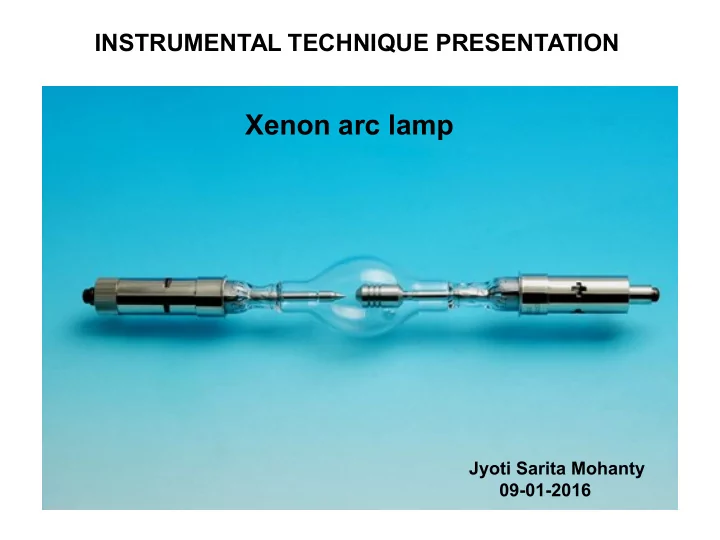

INSTRUMENTAL TECHNIQUE PRESENTATION Xenon arc lamp Jyoti Sarita Mohanty 09-01-2016
What is Xenon arc lamp? Xenon arc lamp is a gas discharge lamp where electric power is converted into light by an arc discharge in a xenon atmosphere at high pressure. It produces bright white light that closely resembles natural sunlight. Xenon has the highest overall conversion efficiency. used in movie projectors in theatres, in searchlights, and for specialized uses in industry and research laboratories. Xenon arc lamps can be roughly divided into three categories: 1. Continuous-output xenon short-arc lamps 2. Continuous-output xenon long-arc lamps 3. Xenon flash lamps (which are usually considered separately)
History of arc lamp Carbon arc lamp was the first electric light invented by Humphry Davy in the early 1800s. This was the first widely-used and commercially successful form of electric lamp. 1875 Pavel Yablochkov had developed the Yablochkov Candle which was the first reliable carbon arc lamp and was used in Paris. 1870s-1890s Elihu Thomson and E.W. Rice Jr improved many parts of the arc light system both in DC and AC power. Then xenon short-arc lamps were invented in the 1940s in Germany and introduced in 1951 by Osram. First launched in the 2 kW size and now it is upto 15 kW.
Xenon arc lamp construction There is a fused quartz envelope with thoriated tungsten electrodes. Fused quartz is the only economically feasible material currently available that can withstand the high pressure and high temp. the tungsten electrodes are welded to strips of pure molybdenum metal or Invar alloy, which are then melted into the quartz to form the envelope seal. Because of the very high power levels involved, large lamps are water-cooled, An O-ring seals off the tube, so that the naked electrodes do not contact the water. In order to achieve maximum efficiency, the xenon gas inside short-arc lamps is maintained at an extremely high pressure — up to 30 atmospheres — which poses safety concerns, large xenon short-arc lamps are normally shipped in protective shields.
The mechanism of light generation In a pure xenon lamp, light is generated within a tiny, pinpoint-sized cloud of plasma situated where the electron stream leaves the face of the cathode. The light generation volume is cone-shaped, and the luminous intensity falls off exponentially moving from cathode to anode causing it to heat. The output of a pure xenon short-arc lamp offers fairly continuous spectral power distribution and light intensity ranges from 20,000 to 500,000 cd/cm 2 . In xenon-mercury short-arc lamps, light is generated in a pinpoint-sized cloud of plasma situated at the tip of each electrode. All xenon short-arc lamps generate substantial ultraviolet radiation and these readily pass through the fused quartz lamp envelope. So some lamps have envelopes made out of ultra-pure synthetic fused silica which allows them to emit useful light into the vacuum UV region.
Spectral distribution of xenon arc lamp Xenon short-arc lamps come in two distinct varieties: (i)pure xenon, which contains only xenon gas; and (ii) xenon-mercury, which contains xenon gas and a small amount of mercury metal.
THANK YOU
Recommend
More recommend